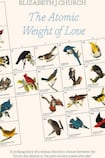
With its backdrop of nuclear bombs, marital discord, burgeoning feminism and love affairs with Vietnam vets, there are sparks of promise in Elizabeth Church's debut novel. Yet, for all its worthy historical terrain and finely noted period detail, the overall effect of The Atomic Weight of Love is more of a whimper than a bang.
Spanning the 1930s to present-day America, Church sets out to record the life of an exceptionally bright woman who never reaches her potential. In a linear narrative, the protagonist Meridian Wallace begins by describing her solitary and education-focused childhood in Pennsylvania. A restrained prose, mixing observation with poetry, conjures up the era and, in particular, the strong bond between Meridian and her academic father.
A subsequent scholarship to the University of Chicago sees the diligent Meri reject socialising for her studies in ornithology, with plans to do a PhD in the behavioural patterns of crows.
Her path to learning is interrupted by a romance with her maths professor Alden Whetstone, 20 years her senior. Like much in the novel, the relationship develops quickly and without much exposition. Drawn to his intelligence and his fine hands, within a few paltry scenes and lacklustre sexual experiences, Meri has agreed to marriage and a move to Los Alamos, New Mexico where Alden has been headhunted for a secret project to help the US win the second World War.
That time is fractured and compressed as the war somewhat mitigates the gaps in their relationship and in the narrative. The interesting history of Los Alamos, where prodigies like Alden work together to create a nuclear bomb, draws the reader into Meridian’s world of sacrifice for a greater good.
Quirky device
Titled chapters denoting the collective nouns of various birds, accompanied by dictionary definitions and literary references, work as a quirky device to structure the novel. From the disquieting opening image of 4,500 red-winged blackbirds dropping dead from the sky, avian symbolism runs throughout the book and mirrors the characters’ behaviour.
Meridian’s wings are clipped from the beginning of her marriage. She postpones her graduate scholarship to Cornell to be with Alden in New Mexico. A year turns to two, then to 10 and finally to decades when Meridian finds herself a middle-aged woman, hugely disgruntled and detached from an unloving and increasingly irredeemable husband.
Church conveys the sense that her narrator is flitting away her life by having the story jump years at a time, but it makes for an awkward read, with clumsy flagging throughout. Sections begin by noting new time eras. The current year or Meri’s age are repeatedly referenced to keep readers abreast.
From Los Alamos, Church has practised law for more than 30 years. She has written extensively for legal publications and scientific journals. This is her first novel and is inspired in part by her parents, a scientist father who worked on the Manhattan Project and her biologist mother who joined him in New Mexico.
Church is a fine writer, never sentimental despite emotive topics, yet her style is so detached that the voice of her narrator is problematic. Meridian's restraint is perhaps understandable for a woman of her era but it is frustrating for fictional purposes. The repressions of women in American society have been the stuff of great literature down through the ages, from Kate Chopin's Edna Pontellier in The Awakening to April Wheeler in Richard Yates's Revolutionary Road. Meri's character suffers from too much general action and not enough reflection.
New millennium
There are the second World War, the atomic age, the Vietnam War and the dawn of the new millennium. We see how women were infantilised for much of the 20th century, with Alden controlling the purse strings and doctors putting Meri’s crippling stomach pains down to hysteria and pseudocyesis or phantom pregnancy.
A relationship in the second half of the book with Vietnam veteran Clay showcases the awakening in US society of the 1960s and 1970s, the backlash against war and the repressions of previous decades. It also brings humour to the novel as Meri discovers oral sex, pot and the hippie culture of “beautiful girls with questionable hygiene”.
With so much going on, however, major topics are glossed over with little psychological depth: how Alden deals with designing an atomic bomb that kills hundreds of thousands; a marriage that is almost dead from the outset; Meri’s not wanting children; her friendship with one of the book’s best characters, Belle, who is sadly killed off as quickly as she arrives.
In trying to span a whole life, Church has missed the details and deeper insights that captivate readers. Epiphanies are damp squibs by the book’s close, with new characters annoyingly introduced in the final chapters to tie up ends and bring Meridian’s feminist awakening full circle.
Grandly proclaimed by its narrator as “the story of a woman who accompanied the bomb’s birth and tried to fly in its aftermath”, this is instead a book that never gets off the ground.











